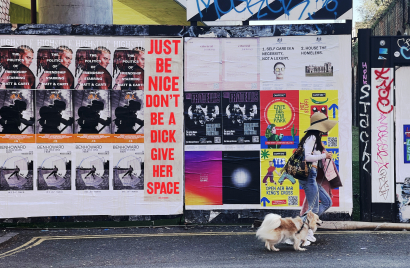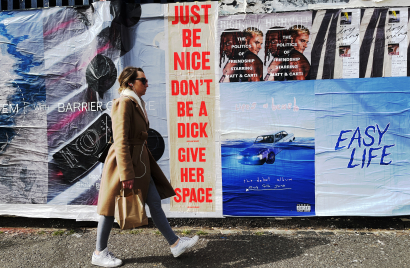
Dreamies investigation proves that the treats are irresistible to cats
The campaign by Adam&EveDDB concludes that the only cats who don’t love the pet treat are human Cats

Sophia Johnson and Sophie Szilady, a creative team at The Brooklyn Brothers, share how they turned to creativity to create the space and the words to confront violence against women.

“The anger we have as women is an act of radical imagination.” In the wake of the murder of Sarah Everard, the words of writer and activist Soraya Chemaly encapsulated the resilience, resolve and creative activism sparked by the national spotlight on the catestrophic scale of violence against women in the United Kingdom.
The shared grief brought with it a virtual outpouring of stories of the realities of simply existing as a woman in a world in which violence and the threat of violence is so omnipresent. While for some the tragedy forced them to consider a reality that they had perhaps never considered before, for many women it provided the space to articulate the often unsaid. The calculations, the keys between fingers, counting the emotional and economic cost of safety in a world in which the first question remains, “why were you alone in the dark?”, instead of asking why violence against women has become so accepted.
The tragedy sparked a national debate and also across the country ignited countless sparks of something else, a desire to do something about it. Across the country women and their allies responded in a myriad of different ways but the message was nonetheless clear: Enough.
The anger we have as women is an act of radical imagination.
Soraya Chemaly, writer and activist
For Sophia Johnson and Sophie Szilady, a creative duo at The Brooklyn Brothers, this spark didn’t linger, but instead turned into an act of radical imagination. A collaborative, thoughtful campaign to reclaim the space so casually denied to women. A campaign which the creative duo explain was ignited by a desire to do something.
“We were sick to the back teeth of systemic sexual harassment full stop,” explains Johnson, pointing to their realisation that there was an opportunity to brighten up, seemingly ‘dodgy’ streets with simple positive reminders to men on how to show up for women against sexual harrasment. She explained: “We wanted to work with someone who could make these messages look really eye-catching. Someone who specialised in sign printing, who has a passion for words and tone. That’s when we reached out to Hackney Dave on Instagram.”
Hackney Dave, an artist also known as Dave Buonaguidi, was the founder St. Luke’s and Karmarama. He is known for his vibrant use of screen printing and in 2003 he created the ‘MAKE TEA NOT WAR’ poster for the anti-war march, which is now part of the collection of the Victoria & Albert museum.
He responded almost immediately and the creative trio spent a Saturday night swapping lines and ideas across Instagram direct messages. This is where the ‘Give Her Space’ campaign came into creation. Within a matter of days the campaign and it’s clear-cut messaging of ‘Give Her Space’ and ‘Don’t be a dick’ was live across London, Birmingham, Bristol and Brighton. While the Instagram page, @giveher_space encouraged people to share what 'give her space' means to them.
The campaign comes in the midst of a unique cultural inflection point when it comes to understanding and acting against violence against women. So what do the creative team believe is the role of creativity when it comes to keeping this issue on the agenda?
For Sophie Szilady the key to Give Her Space is that it isn’t about finger-wagging, blaming or eclipsing the issue. She explains: “We wanted to use creativity to find new ways of addressing the issue, to make something that encourages people to stop and think about their own behaviour and their friends’ behaviour. We want men and women to call out their friends with ‘don’t be a dick’, to ‘give her space’ when running, walking or getting too close on the street, and to remember to ‘just be nice’, especially as we all go back to some sort of normality.”
Through creativity the space for these vital, yet easily ignored conversations can be made. As Johnson adds: “Creative output is really interesting. It has the ability to stop people in their tracks and it can give an emotional response, keeping an issue at the front of all our minds. If we can create everyday behaviour change for the better, what more could you ask for?”
With brands such as John Lewis and Tesco promoting the fact their stores are ‘safe spaces’ in the wake of Sarah Everard’s murder there is a growing move to underline the fact that violence against women is an issue for everyone. Yet, many brands and businesses say nothing for fear of getting it wrong.
As Szilady explains it simply isn’t possible to please all of the people all of the time. “There will always be someone shouting back, no matter what you do, but if you are true to your own values then that’s what matters. There are no seatbelts on the bandwagon. If you’re not following your own values then you’re more likely to be getting it wrong. Brands need to find their own values and then stay true to them. We followed our values and our instincts and gave it a go. We just acted on our values, and if it helps one person change their actions for the better, then for us, that’s what matters,” she explains. A clarity of thinking that keeps action and accountability at the top of the agenda and creative process.
We wanted to use creativity to find new ways of addressing the issue, to make something that encourages people to stop and think about their own behaviour and their friends’ behaviour.
Sophie Szilady, creative The Brooklyn Brothers
This commitment to acting on their values has bought with it a unique creative experience and profoundly personal response to the campaign. As Johnson explains: “To us, Give Her Space is a simple action you can't argue with. It's an opportunity to create physical and metaphorical space for women and men to be open about sexual harassment and hopefully, with it, we can instigate positive behavioural change, no matter how big or small.”
As Johnson continues: “The beauty of Give Her Space is that it is open for anyone who wants to stand up and spread the message against sexual harassment towards women.”
It’s a message which has elicited a phenomenal response from across the globe; from individuals responding to the clarity of the messaging and the space it in turn has created for important conversations.
“The response has been really emotional,” says Szilady. “People from all over the world have been opening up about their experiences and offering their support. From teachers turning the messaging into lesson plans to fathers of young girls who are reaching out to show their support, each message is as moving as the next.”
The creative duo is immensely thankful to the people who have taken the time to share how the campaign has moved them. A unique campaign forged in a late night Instagram collaboration that has now taken on a life of its own as people across the globe take the message into their classrooms and their homes.
So what has been the biggest learning from the creative process? Both are clear-sighted on the answer: “Above all else, just ask.”
As Johnson explains: “When we decided we wanted to create simple messages to men on how to show up for women, we thought we'd chance our arm and message Dave. We didn't expect him to reply. No way. But guess what... he did and he helped us make this a reality in ways we didn't expect.”
When fly-posting company Uncle took up the campaign and pasted them up across the UK the duo inadvertently created one of the most elusive goals in marketing; an overnight success. Yet, the purity of the team’s intent, combined with the creative execution of Buonaguidi, was firmly focused on changing behaviour in the real world. Give Her Space works because it gifts us all the space and the creative spark to ignite a long overdue conversation about the true cost of violence against women.
We followed our values and our instincts and gave it a go. We just acted on our values, and if it helps one person change their actions for the better, then for us, that’s what matters.
Sophie Szilady, creative The Brooklyn Brothers


Looks like you need to create a Creativebrief account to perform this action.
Create account Sign inLooks like you need to create a Creativebrief account to perform this action.
Create account Sign in